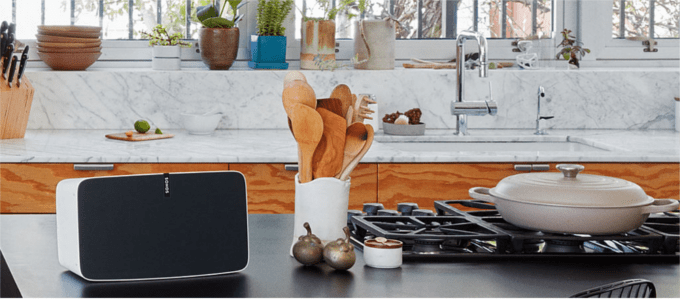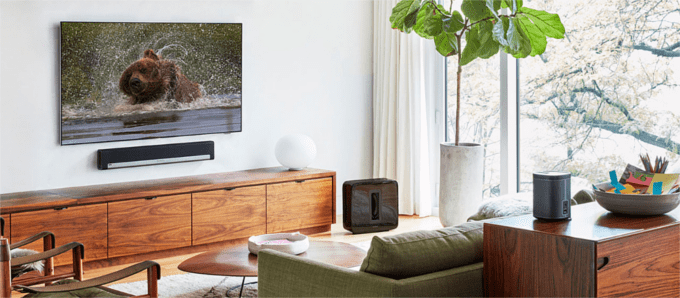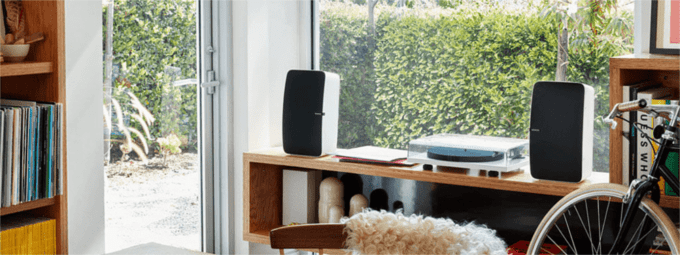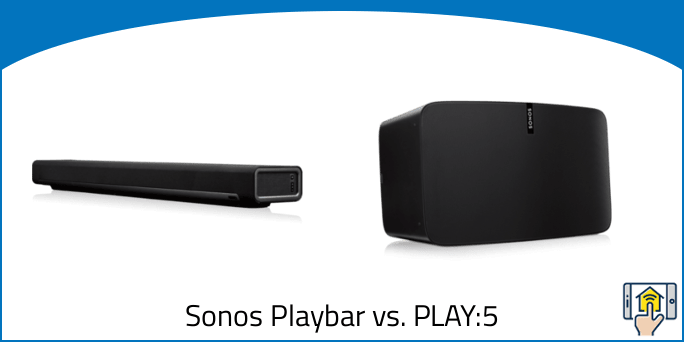There’s a lot to talk about when comparing the Sonos Playbar vs. PLAY:5. Both speakers offer superior sound quality that can adapt to your needs, but they differ in the features that they bring to your home audio experience.
The Sonos Playbar offers high-end design that is just as useful for fleshing out your home theater system as it is playing music, and the PLAY:5 offers flexibility and comprehensive integration that make it a no-brainer for the smart home connoisseur and audiophile alike.
Let’s dive into the similarities and differences between the two speakers so you can figure out which is right for you.
Sonos Playbar vs. PLAY:5 — Differences
Difference #1: Mono & Stereo Output – The Sonos Playbar only offers support for stereo sound, while the PLAY:5 is a little more flexible with differing outputs based on its orientation. When in a vertical position, the PLAY:5 will use mono sound, with stereo sound used when it’s placed horizontally.
Difference #2: Sound Quality – Sound quality is one of the primary concerns of anyone investing in a high-end smart speaker, and there are some key differences in technology when comparing the Sonos Playbar and PLAY:5.
With the PLAY:5, Sonos has really gone above and beyond with three dedicated mid-woofers, three tweeters (one central and two side-firing), and an amplifier for each internal audio technology to really bring the sound to the next level.
The Sonos PlayBar seems to outclass the PLAY:5 in audio quality just through sheer numbers alone, with support for six mid-woofers and 9 amplifiers total.
Difference #3: Audio Line-In – Smart speaker connectivity is important for both the Sonos Playbar and the PLAY:5, but sometimes it’s nice to have the option to use a plain old auxiliary cable in order to play music through the speakers. Whether it’s a record player or your friend’s phone, simply plugging the device into the PLAY:5 will allow you to take advantage of the superior acoustics a Sonos speaker has to offer.
The Sonos Playbar, while retaining all of the cool smart speaker functionality, does not support Line-in.
Difference #4: Connect to TV – While one speaker is a soundbar and the other is a traditional speaker, you can use either one to enhance a home theater.
The PLAY:5 is connected to the TV via a 3.5mm jack, which will stream audio just fine, albeit with a delay that can be rather jarring when it comes to lip-syncing. Even if you can get the audio to sync up seamlessly with the TV, you’ll miss out on IR control with the PLAY:5 — a feature which we touch on in more detail below.
The Sonos Playbar, on the other hand, uses a digital optic cable to connect to your television which should eliminate any sort of audio delay.
Difference #5: IR Control – The number of remotes we have for different types of media devices can quickly get overwhelming. From TV remotes to cable boxes and streaming sticks, it can be difficult to keep track of all of the different tools you need to keep your entertainment functioning the way you desire.
With the Sonos Playbar, you’ll enjoy the IR control that will sync up with nearly any TV, cable box, or universal remote — allowing control over your audio without having to juggle a dedicated remote.
The PLAY:5 does not support IR control as it is not designed with TV in mind, so you’ll have to adjust the audio separately while watching TV.
Difference #6: Dialog Enhancement – Listening to your favorite podcast on a smart speaker can make cleaning up around the house or even just relaxing after a long day a more enjoyable experience. However, sometimes it’s difficult to discern what exactly is being said at different points in the audio.
The Sonos Playbar includes custom drivers that deliver crisp and clear dialog through the central channel where it’s easiest to hear. Speech Enhancement also keeps the dialog at a more consistent level and reduces the volume of any loud sound effects.
The PLAY:5 does not offer support for dialog enhancement.
Difference #7: Night Mode – Another benefit of the Sonos Playbar is its ability to adapt as needed when you need the audio to be quieter. When the entire house is asleep and you still want to binge-watch your favorite shows, Night Mode can emphasize quiet sounds while toning down loud noises — allowing you to continue using the speaker without disturbing those around you.
Difference #8: Humidity Resistant – Sometimes you want to take your smart speaker outside or even start your day off with an energizing playlist while you’re in the shower. The PLAY:5 is built with humidity resistance that allows it to functional in damp environments.
As long as you have access to WiFi and a place to plug it in, you’ll be good to go. Just remember that the speaker is not waterproof or weather-resistant, so you’ll want to be sure to bring it inside if it starts to rain.
The Sonos Playbar is not built with humidity in mind and is best suited to dry environments like the living room or study — especially considering its primary use is as an amplifier for your TV audio.
Difference #9: Ethernet Port – WiFi is a very convenient way to stream audio through your devices, but for the more reliable connection it’s better to use an Ethernet cable. The PLAY:5 comes with one Ethernet port whereas the Playbar comes with two Ethernet ports. Two 10/100 Mbps Ethernet ports allow you to connect the Playbar to your home network and even allow you to use your speaker as a gateway back to your local network. This means that you could connect your Roku or Smart TV into your router through the Playbar rather than through a direct connection, allowing for more flexibility in the positioning of your media technology.
Difference #10: On-Device Controls – In addition to controlling the Sonos Playbar and PLAY:5 through the dedicated Sonos app, both devices offer a way to control the speaker on the device itself. They do differ, however, in how you adjust the various settings.
On the Sonos Playbar, side panel buttons and lights indicate the Play/Pause buttons. An LED also indicates the Sonos component status and mute status.
The PLAY:5 also has touch controls. Tap for the volume and swipe to change the track right from the speaker itself. This allows you to control the speaker at will without having your phone handy, which is a major benefit to the PLAY:5. Overall, the lack of physical buttons on the PLAY:5 gives it a sleeker look when compared to the Playbar.
Difference #11: Voice Control Options – As mentioned above, both the Sonos Playbar and the PLAY:5 feature support for voice control via Amazon Alexa devices. However, the PLAY: 5 will be receiving an update starting in July 2018 that will support AirPlay 2 — finally bringing the ability to control the Sonos speaker using any Siri-enabled device.
The PLAY:5 can also work with Google Home Smart Assistant in more of a roundabout way, as it can be connected via an audio cable and used to play audio on the speaker through voice commands that way.
The Playbar does not have a line-in and cannot be used with Google Assistant in this manner. All in all, the PLAY:5 has wider support for voice controls, so if you’re tied to utilities like AirPlay or Google Assistant it may be the superior option.
Difference #12: Change Orientation – If you’re looking for flexibility in the the way you install and use your smart speaker, the PLAY:5 may be your best bet. With both vertical and horizontal orientations that swap between mono and stereo sound respectively, you’ll have control over both how you orient the speaker and the type of audio that it produces. The rubber feet on 3 sides also make it safe to stand in pretty much any position.
The PlayBar doesn’t offer multiple options for orientation, but it does offer multiple ways to install it. Place it beneath your TV, on a table or console, or mount it on your wall. Whatever your choice, you’ll enjoy some of the best-looking and best-sounding audio the smart speaker market has to offer.
Difference #13: Design – The two smart speakers differ drastically in their design, and while that may not have an effect on function, it may make a difference to those who are looking for a device that will integrate seamlessly with their home aesthetic.
The Sonos Playbar, as the name suggests, is a sound bar – long horizontally without much height or thickness. It’s lighter than the PLAY:5, and the perfect shape to fit under your TV or attach to a wall.
The PLAY:5, on the other hand, is a little bit bigger and looks more like a traditional speaker. It would find its place on a side table or shelf, providing high-fidelity sound that fills the entire room.
Which one looks better depends on your personal preference, as the design is radically different. We’re a fan of the PLAY:5, however, with a more traditional design that could be a design aspect in and of itself rather than a bar with minimal impact.
Sonos Playbar vs. PLAY:5 — Comparison Chart
| Sonos Playbar | Sonos PLAY:5 | |
|---|---|---|
| Mono Output | No | In vertical position |
| Stereo Output | Yes | In horizontal position |
| Class-D Digital Amplifiers | 9 | 6 |
| Tweeter | 3 | 3 |
| Mid-Woofer | 6 | 3 |
| Adjustable Bass & Treble Controls | Yes | Yes |
| A Bass Radiator | No | No |
| Audio line-in | No | Yes |
| Connect to TV | Via Digital Optical Cable | Via AUX Cord |
| Voice Control over Amazon Alexa | Yes | Yes |
| Voice Control Over Siri | No | Coming soon |
| Voice Control Over Google Assistant | No | Via line-in port |
| Amazon Alexa Built-In | No | No |
| Trueplay | Yes | Yes |
| Set Up Over WiFi | Yes | Yes |
| Humidity Resistant | No | Yes |
| WiFi | 802.11b/g, 2.4 GHz | 802.11b/g, 2.4 GHz |
| Bluetooth | No | No |
| Ethernet Port | 2 | 1 |
| Size | Big | Big |
| Dimensions | 3.35 x 35.43 x 5.51 in. (85 x 900 x 140 mm) |
8.03 x 14.33 x 6.06 in. (203 x 364 x 154 mm) |
| Weight | 11.9 lbs. (5.4kg) | 14 lbs. (6.36 kg) |
| Product finish | Black | White or black matte enclosure w/ graphite grille |
| On-Device Control | Button | Touch |
| One App Control | Yes | Yes |
| IR Control | Yes | No |
| Dialog enhancement | Yes | No |
| Night mode | Yes | No |
| Wall Mount | Available | Available |
| Change orientation | No | Yes |
Sonos Playbar vs. PLAY:5 — Things in Common

Stereo Output – There are two primary formats by which speakers deliver content: stereo, and mono. Stereo sound uses multiple “channels” to deliver audio, giving a more well-rounded sound. Both the Sonos Playbar and PLAY:5 feature support for Stereo output, although the latter only uses the format when in a horizontal orientation.
Adjustable Bass & Treble Controls – Each of the two speakers offers adjustable Bass and Treble levels, allowing you complete control over the composition of your sound. The PLAY:5’s three woofers and completely sealed architecture offers superior sound, and the Sonos Playbar features heavily adjustable controls and support for external subwoofers for that rich, dynamic bass.
Set Up Over WiFi – When getting a smart speaker set up and configured, it’s always nice to have settings that make the process as easy as possible. Both the Sonos Playbar and PLAY:5 have support for installation over a WiFi network, and use a 802.11b/g, 2.4 GHz connection to do so.
Trueplay – Audio quality can vary based on where your speaker is located. Factors like the room shape, furniture within, and where the speaker is placed can have a large effect on the type of sound you’ll get from your speakers. Both the Sonos Playbar and PLAY:5 feature Trueplay, which is a system that adjusts audio dynamically to produce a sound best suited for the current environment.
One App Control – A major benefit of smart speakers is their ability to stream music from your favorite online services. With One App Control, each of these smart speakers can stream music from over 80 different streaming services globally. Rather than cycling through a large number of different apps in order to find the music you’re looking for, you can access your entire music collection and adjust various settings all from a single app.
Voice Control over Amazon Alexa – Integration with Amazon Alexa is a major benefit of the Sonos Playbar and PLAY:5, and you can use an Echo or Echo dot in order to play and control your favorite songs, playlists, podcasts, radio stations and more. Additionally, both models have their own Alexa Sonos skills that offer comprehensive voice controls for streaming services like Spotify Premium, Pandora, Deezer, Amazon Music, Tunein, SiriusXM and iHeartRadio. Multiple Sonos speakers are also supported, so you can ask Alexa to play specific music in any area of the house.
Sonos Playbar and PLAY:5 Integration

The Sonos Playbar and PLAY:5 are both excellent devices on their own, but where they really shine is with integration into a sound system or smart home setup.
Adding a Sonos Sub to the Playbar makes for a 3.1 theater sound system experience, and a full set will give you full 5.1 audio.
For 5.1 audio with the PLAY:5, you can add another PLAY:5 speaker in order to make a stereo pair, as well as a Playbar or Beam and a Sub. This setup is very expensive, but will provide excellent sound quality to your home audio system setup.
No products found.
Outside of beefing up the audio, both the Sonos Playbar and the PLAY:5 integrate with a number of other smart products from the company’s partners such as the Lutron smart home system — a utility that will allow you to control your speakers alongside aspects of your home like the lighting, blinds, and temperature. It all boils down to allowing connection and control of all of your devices through a single app, and is a major benefit to both devices.
Sonos Playbar and PLAY:5’s Accessories

Installation of the Sonos Playbar and PLAY:5 is highly customizable, with both smart speakers offering support for different mounts. There are options available on Amazon both for wall mounting and for integrating your Playbar with a TV – allowing for easy access to two of the most common installation methods.
The PLAY:5 also has multiple options, with support for both a wall mount and a stand mount should you be looking for dedicated spot to install rather than setting it down on a table or shelf.
In addition to multiple methods of installation customization, both the Sonos Playbar and the PLAY:5 support Sonos Boost — an accessory that plugs into your router in order to provide a dedicated network for your speakers and eliminate nearly every instance of a spotty connection.
Sonos Playbar vs. PLAY:5 — Our Thoughts

The Sonos Playbar and PLAY:5 both have their benefits and drawbacks, and it’s difficult to declare one “better” in all situations.
The PLAY:5 has excellent audio quality, flexible installation, an audio line-in, and support for a number of voice controllers – making it a go-to device for music. It lacks some of the audio fidelity of the Playbar, however, as well as some neat features like better dialogue and night mode.
With the Playbar’s support for lag-free audio, IR control, and easy integration with a home theater system, it’s a viable option for more than just playing the latest hits. With fewer options for voice controllers, no line-in, and no resistance to humidity, it does fall behind the PLAY:5 in a number of important areas.
Which speaker is best for you will depend on your individual needs, but we recommend the PLAY:5 for music and the Playbar for adding to your home theater system.
Last update on 2024-04-18 at 22:16 / Affiliate links / Images from Amazon Product Advertising API





